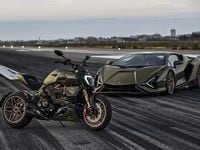Will your next sportbike wear a Harley-Davidson bar-and-shield logo on its gas tank? Maybe. Beginning next year, The Motor Company is expected to launch what it claims will be a wider-ranging model line to compete "in many of the largest- and fastest-growing segments with a full portfolio of motorcycles across a broad spectrum of price points, power sources, displacements, riding styles, and global markets."
One of those motorcycles is this machine, a streetfighter suggestive of the Buell Lightning series and powered by what appears to be an all-new, liquid-cooled, overhead-cam, narrow-angle V-twin that Harley says displaces 975cc. For reference, the current Sportster has an air-cooled, OHV, 45-degree V-twin displacing either 883 or 1,202cc. The Street line, meanwhile, uses a liquid-cooled, SOHC, 60-degree engine in 494 and 749cc capacities.
The single-shock frame and swingarm for this prototype look like a mix of aluminum castings. An inverted fork carries dual disc brakes with four-piston Brembo calipers. Michelin radials are mounted on 17-inch Y-spoke wheels front and rear. Overall, the photo bike looks nicely finished, production quality even, right down to the turn signals and handlebar-end mirrors. This example won’t be going anywhere soon, however, as the final drive pulley is missing a requisite toothed belt.
Harley-Davidson has been down the sportbike road before but more recently focused its attention on the core cruiser and touring business. Nearly a decade ago, H-D shuttered the Buell Motorcycle Company and sold its interest in MV Agusta. "Our strategy to focus on the Harley-Davidson brand reflects the fact that we believe our investments in that brand are a better utilization of overall company resources," then-CEO Keith Wandell said at the time.
Now, Harley-Davidson is expanding again—engines, platforms, market segments, including several proposed electric models with varying missions—and that includes launching what could be the sportiest and possibly best-handling streetbike it has ever produced and powered by a modern liter-class V-twin, the modularity of which, we’re told, will deliver no fewer than four displacement options for use in at least three categories.
/cloudfront-us-east-1.images.arcpublishing.com/octane/5UNL6KAQZKTANF4W5T7J6EYFBU.jpg)
/cloudfront-us-east-1.images.arcpublishing.com/octane/FCX7A77F4XHPM7JAX44ASTS2YY.jpg)
/cloudfront-us-east-1.images.arcpublishing.com/octane/L2Y4WRZR5J47OGKRLAYNA62QOM.jpg)
/cloudfront-us-east-1.images.arcpublishing.com/octane/RMCT2KVQBJHBZMRTSLOVPMOILU.jpg)

/cloudfront-us-east-1.images.arcpublishing.com/octane/K45KB2XHQVA65DX7VN4ZSMT2BI.jpg)
/cloudfront-us-east-1.images.arcpublishing.com/octane/BIVAK2SFIBDJJM25E7I5VU2FJE.jpg)
/cloudfront-us-east-1.images.arcpublishing.com/octane/FNHXQQ56BRD7TO4YIJ453PNG2M.jpg)
/cloudfront-us-east-1.images.arcpublishing.com/octane/OIKJC4JA3ZH7BMKUGWYKBIY5FA.jpg)
/cloudfront-us-east-1.images.arcpublishing.com/octane/MT2SAEWY6FDXFBYSLDE3AEFDTM.jpg)
/cloudfront-us-east-1.images.arcpublishing.com/octane/66UPKPYVURBPRCP5HXSN56MEMM.jpg)
/cloudfront-us-east-1.images.arcpublishing.com/octane/EOREGDSRKFDCRJC6K3EDVHBGCE.jpg)
/cloudfront-us-east-1.images.arcpublishing.com/octane/42RF63Q3LVCMBP3DGTWXFYSMOA.jpg)
/cloudfront-us-east-1.images.arcpublishing.com/octane/XNVY3EVWZFCEVPUGJGAN633LXE.jpg)
/cloudfront-us-east-1.images.arcpublishing.com/octane/2PLTVHXY7FDSPFHKU5CFOC43ZY.jpg)
/cloudfront-us-east-1.images.arcpublishing.com/octane/B6M3WTRLFZGNXBEATNXPVGBBD4.jpg)
/cloudfront-us-east-1.images.arcpublishing.com/octane/4CMH3FI73BEM5D6MFYX42FLDSQ.jpg)
/cloudfront-us-east-1.images.arcpublishing.com/octane/RIHAPYNWU5H3XAOXNOPRWCBTQA.jpg)
/cloudfront-us-east-1.images.arcpublishing.com/octane/HU4NUBCL3VAFZA75VYRCMAUHVM.jpg)
/cloudfront-us-east-1.images.arcpublishing.com/octane/OB43AZK7TRA6XLZL5WRDVW2TDA.jpg)
/cloudfront-us-east-1.images.arcpublishing.com/octane/5G44Y3FXWNFSTEQKCA355PXOPU.jpg)

/cloudfront-us-east-1.images.arcpublishing.com/octane/XRI4GTLCVBA5NESASCBIR5LYQI.jpg)
/cloudfront-us-east-1.images.arcpublishing.com/octane/EF7566PXARGMBAOMLWTECYL3LE.jpg)


